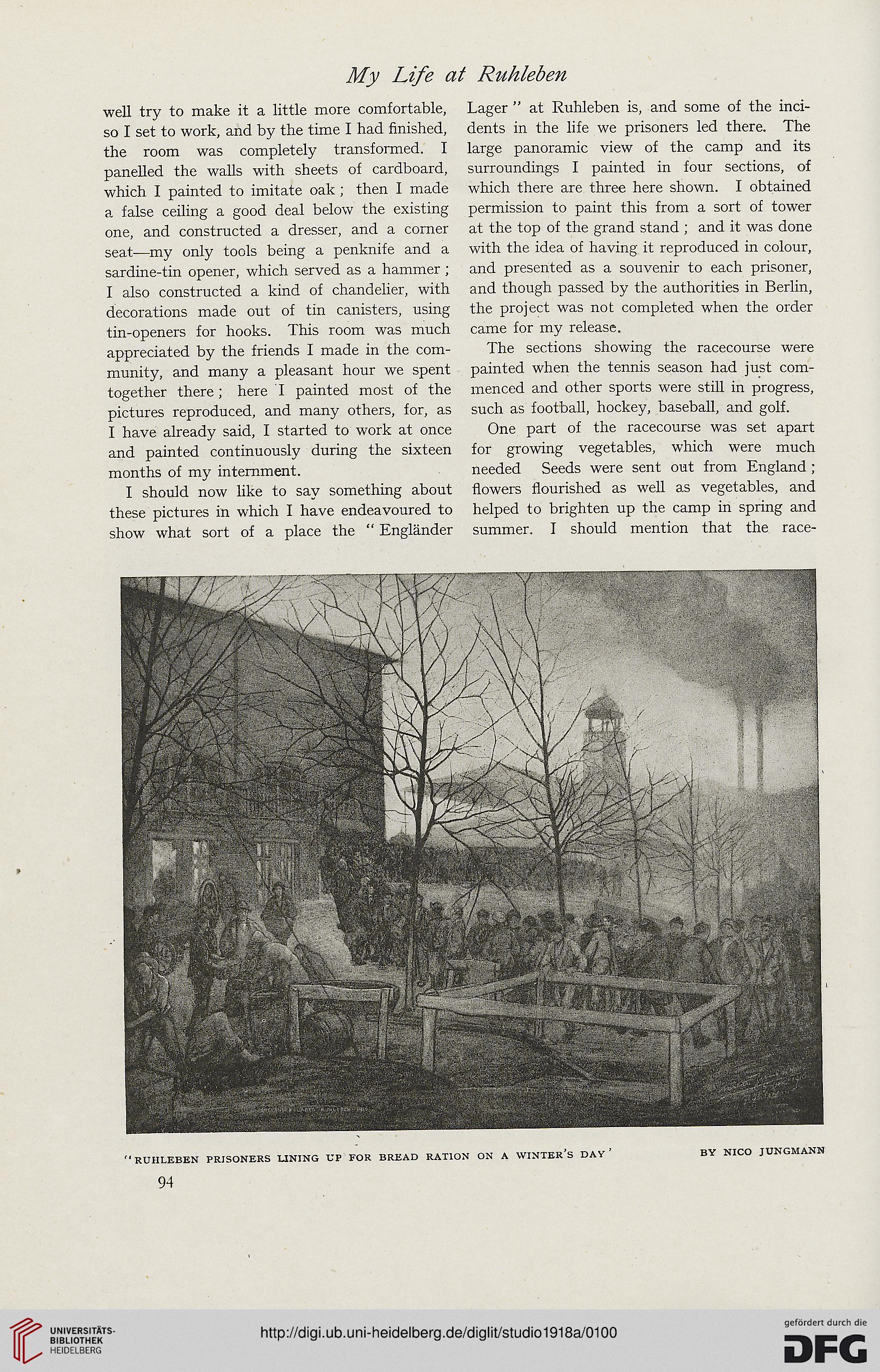My Life at Ruhleben
well try to make it a little more comfortable,
so I set to work, and by the time I had finished,
the room was completely transformed. I
panelled the walls with sheets of cardboard,
which I painted to imitate oak ; then I made
a false ceiling a good deal below the existing
one, and constructed a dresser, and a corner
seat—my only tools being a penknife and a
sardine-tin opener, which served as a hammer;
I also constructed a kind of chandelier, with
decorations made out of tin canisters, using
tin-openers for hooks. This room was much
appreciated by the friends I made in the com-
munity, and many a pleasant hour we spent
together there; here I painted most of the
pictures reproduced, and many others, for, as
I have already said, I started to work at once
and painted continuously during the sixteen
months of my internment.
I should now like to say something about
these pictures in which I have endeavoured to
show what sort of a place the " Englander
Lager " at Ruhleben is, and some of the inci-
dents in the life we prisoners led there. The
large panoramic view of the camp and its
surroundings I painted in four sections, of
which there are three here shown. I obtained
permission to paint this from a sort of tower
at the top of the grand stand ; and it was done
with the idea of having it reproduced in colour,
and presented as a souvenir to each prisoner,
and though passed by the authorities in Berlin,
the project was not completed when the order
came for my release.
The sections showing the racecourse were
painted when the tennis season had just com-
menced and other sports were still in progress,
such as football, hockey, baseball, and golf.
One part of the racecourse was set apart
for growing vegetables, which were much
needed Seeds were sent out from England ;
flowers flourished as well as vegetables, and
helped to brighten up the camp in spring and
summer. I should mention that the race-
" RUHLEBEN PRISONERS LINING UP FOR BREAD RATION ON A WINTER'S DAY '
94
BY NICO JUNGMANN
well try to make it a little more comfortable,
so I set to work, and by the time I had finished,
the room was completely transformed. I
panelled the walls with sheets of cardboard,
which I painted to imitate oak ; then I made
a false ceiling a good deal below the existing
one, and constructed a dresser, and a corner
seat—my only tools being a penknife and a
sardine-tin opener, which served as a hammer;
I also constructed a kind of chandelier, with
decorations made out of tin canisters, using
tin-openers for hooks. This room was much
appreciated by the friends I made in the com-
munity, and many a pleasant hour we spent
together there; here I painted most of the
pictures reproduced, and many others, for, as
I have already said, I started to work at once
and painted continuously during the sixteen
months of my internment.
I should now like to say something about
these pictures in which I have endeavoured to
show what sort of a place the " Englander
Lager " at Ruhleben is, and some of the inci-
dents in the life we prisoners led there. The
large panoramic view of the camp and its
surroundings I painted in four sections, of
which there are three here shown. I obtained
permission to paint this from a sort of tower
at the top of the grand stand ; and it was done
with the idea of having it reproduced in colour,
and presented as a souvenir to each prisoner,
and though passed by the authorities in Berlin,
the project was not completed when the order
came for my release.
The sections showing the racecourse were
painted when the tennis season had just com-
menced and other sports were still in progress,
such as football, hockey, baseball, and golf.
One part of the racecourse was set apart
for growing vegetables, which were much
needed Seeds were sent out from England ;
flowers flourished as well as vegetables, and
helped to brighten up the camp in spring and
summer. I should mention that the race-
" RUHLEBEN PRISONERS LINING UP FOR BREAD RATION ON A WINTER'S DAY '
94
BY NICO JUNGMANN




